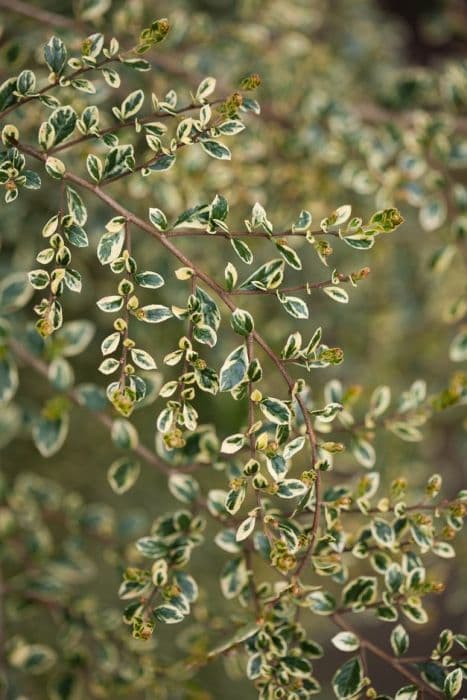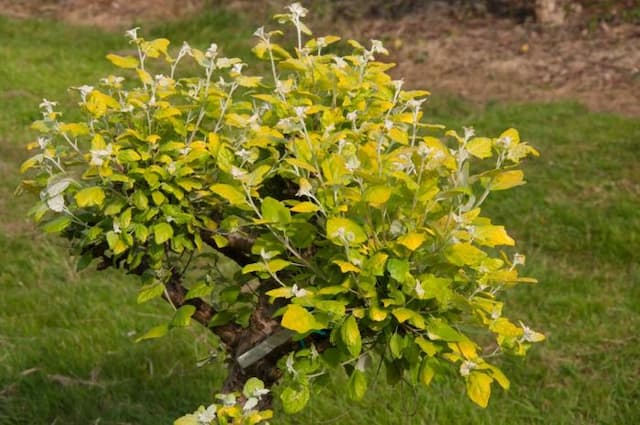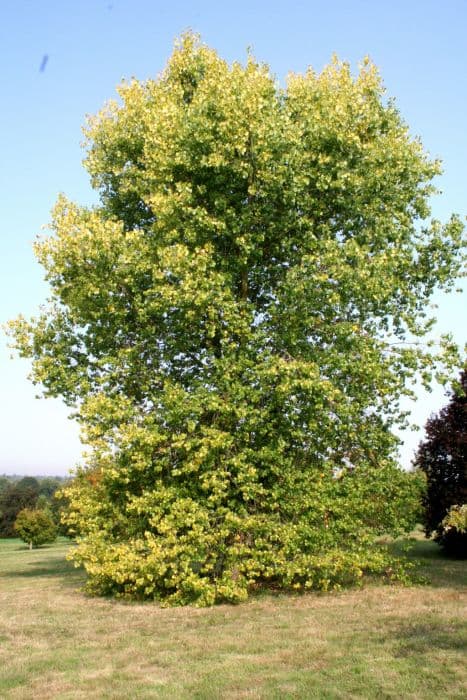Boxleaf Azara Azara microphylla

ABOUT
The plant known as Boxleaf Azara is an evergreen shrub with a bushy and dense growing habit. Its small, glossy leaves are arranged in a neat, overlapping fashion along the branches, giving it a textured and lush appearance. The leaves are a rich, dark green which provides a perfect backdrop for its tiny, but profusely borne flowers. These flowers are often not conspicuous at a distance due to their size, but up close they reveal an intricate structure and are generally a pale yellow color, which contrasts subtly against the dark foliage. The flowers, which may appear in clusters, give off a delightful vanilla or chocolatey fragrance that can be quite noticeable even from several feet away, especially on warm days. Following the flowering period, the plant may produce small, purple-black berries that are attractive to birds and other wildlife, although they are not particularly showy to the human eye. The attractive qualities of the Boxleaf Azara, especially its compact foliage and aromatic flowers, make it a favored choice for garden landscapes that aim to provide sensory experiences or dense greenery without requiring large areas for growth.
About this plant
 Names
NamesFamily
Salicaceae
Synonyms
Boxleaf Azara, Vanilla Plant, Small-leaved Azara
Common names
Azara microphylla Hook.f.
 Toxicity
ToxicityTo humans
Boxleaf Azara is not commonly known to be toxic to humans. There is limited information available about its toxicity; however, as with many plants, it is always advisable to avoid ingesting parts of plants that are not traditionally used for food, as they can sometimes cause adverse reactions.
To pets
Boxleaf Azara is not widely recognized as a toxic plant for pets either. Similar to the precaution for humans, it is not intended for pet consumption and could potentially cause mild stomach upset if ingested due to the novelty and non-food nature of the plant to pets. However, there are no specific symptoms of poisoning associated with this plant documented for pets in readily available information up to my last update. Owners should still exercise caution and prevent pets from ingesting the plant.
 Characteristics
CharacteristicsLife cycle
Perennials
Foliage type
Evergreen
Color of leaves
Green
Flower color
Yellow
Height
10-15 feet (3-4.5 meters)
Spread
6-10 feet (1.8-3 meters)
Plant type
Shrub
Hardiness zones
7
Native area
South America
Benefits
 General Benefits
General Benefits- Aesthetic Appeal: Azara microphylla, commonly known as Boxleaf Azara, has small glossy leaves and a compact growth habit, making it an attractive choice for gardens and landscapes.
- Wildlife Habitat: The plant produces small, fragrant yellow flowers that attract a variety of pollinators, including bees and butterflies, providing a beneficial habitat for local wildlife.
- Evergreen Foliage: As an evergreen, Boxleaf Azara provides year-round greenery, enhancing garden color even in the cooler months.
- Privacy Screening: Its dense and bushy nature makes it an excellent choice for creating privacy screens or hedges in residential and commercial settings.
- Low Maintenance: Boxleaf Azara requires minimal pruning and can thrive without extensive care, making it suitable for gardeners seeking low-maintenance plants.
- Adaptability: It adapts well to a range of soil types and can tolerate both sun and partial shade, making it versatile for planting in various garden conditions.
- Windbreak: The sturdy and dense growth of Boxleaf Azara can serve as a windbreak, protecting more sensitive plants and creating a calmer garden environment.
- Sound Absorption: The dense foliage can help to absorb and reduce noise pollution, creating a quieter and more serene outdoor space.
- Urban Tolerance: Boxleaf Azara is known to be tolerant of pollution and urban conditions, which makes it a suitable plant for city landscaping.
- Coastal Conditions: It can also withstand coastal conditions, including salt spray, making it ideal for seaside gardens.
 Medical Properties
Medical PropertiesThis plant is not used for medical purposes.
 Air-purifying Qualities
Air-purifying QualitiesThis plant is not specifically known for air purifying qualities.
 Other Uses
Other Uses- Azara microphylla, commonly known as the Boxleaf Azara, can be utilized as a natural insect repellent when its leaves are crushed and spread in areas where insects are unwanted, due to the aromatic compounds it emits.
- The plant's dense foliage provides excellent cover for birds and other wildlife, which can make Boxleaf Azara a valuable addition to wildlife gardens or conservation areas.
- The wood of Boxleaf Azara can be fashioned into small wooden objects such as buttons or beads, given its moderate hardness and fine grain.
- Some cultures use the fragrant flowers of the Boxleaf Azara in perfumery, taking advantage of their vanilla-like scent to create unique olfactory experiences.
- In bonsai culture, Azara microphylla can be trained into miniature tree forms using wiring and pruning techniques due to its small leaves and adaptability to pruning.
- The evergreen nature of Boxleaf Azara makes it a reliable privacy screen throughout the year, ideal for use in hedging and as a visual barrier in gardens.
- Dye can be extracted from the bark and leaves of the Boxleaf Azara for use in textile coloring, albeit this is not a commonly practiced application.
- Boxleaf Azara twigs and foliage can be included in floral arrangements, wreaths, and other decorative crafts, providing texture and greenery with their small, glossy leaves.
- When creating natural sound barriers, Boxleaf Azara's dense growth helps absorb and reduce noise pollution, making it a multifunctional plant in urban planning.
- The plant can be used in companion planting, as its dense root system can help stabilize soil, prevent erosion, and provide support for more delicate neighboring plants.
Interesting Facts
 Feng Shui
Feng ShuiThe Boxleaf Azara is not used in Feng Shui practice.
 Zodiac Sign Compitability
Zodiac Sign CompitabilityThe Boxleaf Azara is not used in astrology practice.
 Plant Symbolism
Plant Symbolism- Resilience - Azara microphylla, commonly known as the Boxleaf Azara, is an evergreen shrub that can withstand diverse growing conditions, symbolizing the ability to persevere and sustain oneself through challenges.
- Adaptability - The Boxleaf Azara is noted for its versatile nature, being able to adapt to different lighting conditions, which mirrors the quality of being flexible and adjusting to various situations in life.
- Beauty in simplicity - With its small leaves and inconspicuous flowers, the Boxleaf Azara represents the idea that there is elegance and grace in simplicity, and beauty does not always have to be ostentatious.
- Sensory pleasure - The tiny flowers of the Boxleaf Azara may be overlooked visually, but they emit a delightful fragrance, reminding us to find joy in the subtle, often hidden, pleasures of life.
 Water
WaterFor the Azara microphylla, commonly known as Boxleaf Azara, watering should be done thoroughly, ensuring the soil is moist but not waterlogged. It typically requires watering once a week, but this may vary depending on climate conditions and soil type. During the growing season in spring and summer, it may need more frequent watering, about 1-2 gallons depending on the size of the plant. In the dormant winter months, reduce watering to every other week or when the soil feels dry to the touch about an inch below the surface. Always check the topsoil for dryness before watering to avoid over-watering which can lead to root rot.
 Light
LightBoxleaf Azara thrives best in partial shade to full sun conditions. It prefers bright, indirect light if kept indoors and can handle some direct sunlight, especially in cooler climates. The ideal spot for this plant is one where it can receive morning sun and afternoon shade, or dappled sunlight throughout the day, to protect its foliage from harsh midday rays.
 Temperature
TemperatureBoxleaf Azara grows best in a temperature range between 50°F to 80°F. It can survive minimum temperatures down to about 20°F, making it relatively frost-hardy. To ensure optimal growth, protect the plant from extremes, especially during sudden cold snaps. The ideal conditions are a consistently temperate environment without frequent fluctuations.
 Pruning
PruningPrune Boxleaf Azara to maintain shape and encourage bushier growth. Pruning is best done in late winter or early spring before new growth starts. It can be pruned annually or as needed to remove any dead or damaged branches. Pruning also allows for controlling the size and ensuring good air circulation within the plant structure.
 Cleaning
CleaningAs needed
 Soil
SoilThe Boxleaf Azara thrives in a well-drained soil mix with good organic content, ideally one that is rich in humus. A mix of two parts loam, one part peat, and one part sharp sand can provide the drainage and nutrients it needs. The ideal pH range for Boxleaf Azara is slightly acidic to neutral, around pH 5.5 to 7.5.
 Repotting
RepottingThe Boxleaf Azara should be repotted every 2-3 years to prevent becoming root-bound and to refresh the soil. Younger plants may benefit from more frequent repotting, whereas mature plants can be repotted less frequently as their growth slows down.
 Humidity & Misting
Humidity & MistingThe Boxleaf Azara prefers moderate to high humidity levels, ideally around 40-60%. Consistent humidity is favorable for this plant, as it simulates the moist environments of its native habitat. Avoid placing it in exceptionally dry conditions.
 Suitable locations
Suitable locationsIndoor
Place Boxleaf Azara in bright, indirect light inside, away from drafts.
Outdoor
Plant Boxleaf Azara in partial shade with sheltered conditions outside.
Hardiness zone
8-10 USDA
 Life cycle
Life cycleAzara microphylla, also known as the Boxleaf Azara, begins its life cycle as a seed, typically dispersed by birds that have eaten its fruit. When conditions are favorable – moist soil and partial shade – the seed germinates and a seedling emerges. This seedling stage involves the development of a taproot and first true leaves, establishing the plant in its substrate. As the Boxleaf Azara matures into a young plant, it develops more robust foliage with its characteristic small, glossy, evergreen leaves, and begins to branch out. During the adult stage, it produces small, inconspicuous yellow flowers in the spring, which possess a vanilla-like fragrance, leading to the development of purple-black berries in the summer, if pollinated. This plant is a perennial and can live for many years, during which time it will continue to grow in height and spread, undergoing cycles of flowering and fruiting seasonally.
 Propogation
PropogationPropogation time
Spring
Azara microphylla, commonly known as Boxleaf Azara, can be propagated through semi-hardwood cuttings. The ideal time to take cuttings for propagation is in the late summer when growth has started to mature. To propagate through cuttings, one should select a healthy, disease-free branch and cut a piece about 4 to 6 inches (approximately 10 to 15 centimeters) long with several leaf nodes. The lower leaves are removed, and the cut end can be dipped in a rooting hormone to encourage root development. This cutting should then be placed in a well-draining potting mix, ensuring at least one node is buried beneath the soil surface. The cuttings require a warm, humid environment to root successfully, which can be achieved by covering the pot with a plastic bag or placing it in a propagator. With proper care, the cutting will develop roots and can eventually be transferred to a larger pot or directly into the garden.









